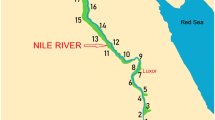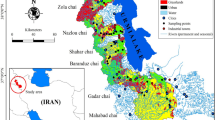Abstract
Rapid industrialization and urbanization have resulted in heavy metal(loid) pollution in aquatic environments in China. It may be beneficial to dredge sediments with low levels of metal(loid) contamination and utilize the nutrient-rich sediments in agricultural applications. However, relatively little is known about the human health risks from heavy metal(loid)s and nutrients in river sediments. In this study, sediment pollution levels and human health risks from seven heavy metal(loid)s and a range of nutrients in Fuchunjiang River (Ningbo, Zhejiang) sediment were investigated in eleven surface samples. Higher Zn, Cd, Cu, As, Pb, Ni, and Cr concentrations were measured in surface sediments compared with local background concentrations. Geoaccumulation index (Igeo) values show that sediments are moderately to heavily polluted by Cd and Zn, moderately polluted by Cu, and unpolluted to moderately polluted by As, Ni, and Pb. The concentrations of As, Zn, Ni, and Cr pose a risk to aquatic biota. However, mean metal(loid)s concentrations were lower than intervention values stated in GB15618-2018 (the State Standard of the People’s Republic of China). The hazard index (HI) and cancer risk (CR) values for humans were lower than acceptable levels, suggesting little or no health risks from heavy metal(loid) contaminated sediments. The high organic matter (OM) and available potassium (AK) concentrations and low alkaline hydrolysis nitrogen (AN) concentration suggest that the river sediments are suitable for agricultural utilization and would provide valuable resources for agricultural soils.


Similar content being viewed by others
References
Alsbou EME, Al-Khashman OA (2018) Heavy metal concentrations in roadside soil and street dust from Petra region, Jordan. Environ Monit Assess 190:48
Belabed BE, Meddour A, Samraoui B, Chenchouni H (2017) Modeling seasonal and spatial contamination of surface waters and upper sediments with trace metal elements across industrialized urban areas of the Seybouse watershed in North Africa. Environ Monit Assess 189:265
Bermejo JC, Beltran R, Ariza JL (2004) Spatial variations of heavy metals contamination in sediments from Odiel river (Southwest Spain). Environ Int 29:69–77
Chen YM, Gao JB, Yuan YQ, Ma J, Yu S (2016) Relationship between heavy metal contents and clay mineral properties in surface sediments: Implications for metal pollution assessment. Cont Shelf Res 124:125–133
Cheung KC, Poon BHT, Lan CY, Wong MH (2003) Assessment of metal and nutrient concentrations in river water and sediment collected from the cities in the Pearl River Delta, South China. Chemosphere 52:1431–1440
China National Environmental Monitoring Center (CNEMC) (1990) Chinese Elemental Background Values for Soils. Chinese Environmental Science Press Beijing, Beijing
Costa-Boddeker S, Thuyen LX, Hoelzmann P, de Stigter HC, van Gaever P, Huy HD, Schwalb A (2018) The hidden threat of heavy metal pollution in high sedimentation and highly dynamic environment: Assessment of metal accumulation rates in the Thi Vai Estuary, Southern Vietnam. Environ Pollut 242:348–356
Fu J, Zhao C, Luo Y, Liu C, Kyzas GZ, Luo Y, Zhao D, An S, Zhu H (2014) Heavy metals in surface sediments of the Jialu River, China: their relations to environmental factors. J Hazard Mater 270:102–109
Gu YG, Gao YP, Lin Q (2016) Contamination, bioaccessibility and human health risk of heavy metals in exposed-lawn soils from 28 urban parks in southern China's largest city, Guangzhou. Appl Geochem 67:52–58
Haddout S, Priya KL, Casila JCC, Samad B (2021) Assessment of heavy metal contamination in the surficial sediments from the Sebou River Estuary, Morocco. Environ Forensic 1-9.
Harwood JJ (2014) Molecular markers for identifying municipal, domestic and agricultural sources of organic matter in natural waters. Chemosphere 95:3–8
Hossain MB, Shanta TB, Ahmed ASS, Hossain MK, Semme SA (2019) Baseline study of heavy metal contamination in the Sangu River estuary, Chattogram, Bangladesh. Mar Pollut Bull 140:255–261
Ito T, Adachi Y, Yamanashi Y, Shimada Y (2016) Long-term natural remediation process in textile dye-polluted river sediment driven by bacterial community changes. Water Res 100:458–465
Jacquiod S, Cyriaque V, Riber L, Al-Soud WA, Gillan DC, Wattiez R, Sorensen SJ (2018) Long-term industrial metal contamination unexpectedly shaped diversity and activity response of sediment microbiome. J Hazard Mater 344:299–307
Kaushik A, Kansal A, Santosh M, Kumari S, Kaushik CP (2009) Heavy metal contamination of river Yamuna, Haryana, India: assessment by Metal Enrichment Factor of the Sediments. J Hazard Mater 164:265–270
Ke X, Gui S, Huang H, Zhang H, Wang C, Guo W (2017) Ecological risk assessment and source identification for heavy metals in surface sediment from the Liaohe River protected area, China. Chemosphere 175:473–481
Khademi H, Gabarron M, Abbaspour A, Martinez-Martinez S, Faz A, Acosta JA (2019) Environmental impact assessment of industrial activities on heavy metals distribution in street dust and soil. Chemosphere 217:695–705
Knox AS, Paller MH, Milliken CE, Redder TM, Wolfe JR, Seaman J (2016) Environmental impact of ongoing sources of metal contamination on remediated sediments. Sci Total Environ 563-564:108–117
Kurt-Karakus PB (2012) Determination of heavy metals in indoor dust from Istanbul, Turkey: estimation of the health risk. Environ Int 50:47–55
Li SW, Sun HJ, Li HB, Luo J, Ma LQ (2016) Assessment of cadmium bioaccessibility to predict its bioavailability in contaminated soils. Environ Int 94:600–606
Liang ZW, Siegert M, Fang W, Sun Y, Jiang F, Lu H, Chen GH, Wang S (2018) Blackening and odorization of urban rivers: a bio-geochemical process. FEMS Microbiol Ecol 94:1–12
Liu X, Jiang J, Yan Y, Dai Y, Deng B, Ding S, Su S, Sun W, Li Z, Gan Z (2018) Distribution and risk assessment of metals in water, sediments, and wild fish from Jinjiang River in Chengdu, China. Chemosphere 196:45–52
Lu RK (2000) Analytical methods for soil and agricultural chemistry. China Agricultural Science and Technology Press, Beijing
Ma X, Zuo H, Tian M, Zhang L, Meng J, Zhou X, Min N, Chang X, Liu Y (2016) Assessment of heavy metals contamination in sediments from three adjacent regions of the Yellow River using metal chemical fractions and multivariate analysis techniques. Chemosphere 144:264–272
Maanan M, Saddik M, Maanan M, Chaibi M, Assobhei O, Zourarah B (2015) Environmental and ecological risk assessment of heavy metals in sediments of Nador lagoon, Morocco. Ecol Indic 48:616–626
Man YB, Sun XL, Zhao YG, Lopez BN, Chung SS, Wu SC, Cheung KC, Wong MH (2010) Health risk assessment of abandoned agricultural soils based on heavy metal contents in Hong Kong, the world's most populated city. Environ Int 36:570–576
Men C, Liu R, Xu F, Wang Q, Guo L, Shen Z (2018) Pollution characteristics, risk assessment, and source apportionment of heavy metals in road dust in Beijing, China. Sci Total Environ 612:138–147
Ministry of Ecology and Environment of People's Republic of China (2018) Soil environmental quality risk control standard for soil contamination of agricultural land
Oomen AG, Hack A, Minekus M (2002) Comparison of five in vitro digestion models to study the bioaccessibility of soil contaminants. Environ Sci Technol 36:3326–3334
Pandey M, Pandey AK, Mishra A, Tripathi BD (2015) Assessment of metal species in river Ganga sediment at Varanasi, India using sequential extraction procedure and SEM-EDS. Chemosphere 134:466–474
Peng JF, Song YH, Yuan P, Cui XY, Qiu GL (2009) The remediation of heavy metals contaminated sediment. J Hazard Mater 161:633–640
Perelo LW (2010) Review: in situ and bioremediation of organic pollutants in aquatic sediments. J Hazard Mater 177:81–89
Phillips DJH (1995) The chemistries and environmental fates of trace metals and organochlorines in aquatic ecosystems. Mar Pollut Bull 31:193–200
Rajeshkumar S, Liu Y, Zhang X, Ravikumar B, Bai G, Li X (2018) Studies on seasonal pollution of heavy metals in water, sediment, fish and oyster from the Meiliang Bay of Taihu Lake in China. Chemosphere 191:626–638
Roca-Perez L, Martinez C, Marcilla P, Boluda R (2009) Composting rice straw with sewage sludge and compost effects on the soil-plant system. Chemosphere 75:781–787
Skordas K, Kelepertzis E, Kosmidis D, Panagiotaki P, Vafidis D (2015) Assessment of nutrients and heavy metals in the surface sediments of the artificially lake water reservoir Karla, Thessaly, Greece. Environ Earth Sci 73:4483–4493
Smith SL, Macdonald DD, Keenleyside KA, Ingersoll CG, Field LJ (1996) A preliminary evaluation of sediment quality assessment values for freshwater ecosystems. J Gt Lakes Res 22:624–638
Smith VH, Tilman GD, Nekola JC (1999) Eutrophication: impacts of excess nutrient inputs on freshwater, marine, and terrestrial ecosystems. Environ Pollut 100:179–196
Song Z, Gao H, Zhu P, Peng C, Deng A, Zheng C, Mannaf MA, Islam MN, Zhang W (2015) Organic amendments increase corn yield by enhancing soil resilience to climate change. Crop J 3:110–117
Sun Q, Sheng Y, Yang J, Di Bonito M, Mortimer RJG (2016) Dynamic characteristics of sulfur, iron and phosphorus in coastal polluted sediments, north China. Environ Pollut 219:588–595
U.S. Environmental Protection Agency (2001) Supplemental guidance for developing soil screening levels for superfund sites. OSWER9355.4-24. Office of Solid Waste and Emergency Response. US Environmental Protection Agency. Washington, DC
U.S. Environmental Protection Agency (2002) Supplemental guidance for developing soil screening levels for superfund sites[M]. Office of Emergency and Remedial Response, Washington
U.S. Environmental Protection Agency (2011) Exposure factor handbook 2011 edition EPA/600/R-090/052F. National Center for Environmental Assessment, Office of Research and Development, United States Environmental Protection Agency, Washington
USDoE (2011) The Risk Assessment Information System (RAIS). U.S. Department of Energy’s Oak Ridge Operations Office (ORO)
Varol M (2011) Assessment of heavy metal contamination in sediments of the Tigris River (Turkey) using pollution indices and multivariate statistical techniques. J Hazard Mater 195:355–364
Vitkova M, Puschenreiter M, Komarek M (2018) Effect of nano zero-valent iron application on As, Cd, Pb, and Zn availability in the rhizosphere of metal(loid) contaminated soils. Chemosphere 200:217–226
Wang W, Wang WX (2016) Phase partitioning of trace metals in a contaminated estuary influenced by industrial effluent discharge. Environ Pollut 214:35–44
Xia F, Qu L, Wang T, Luo L, Chen H, Dahlgren RA, Zhang M, Mei K, Huang H (2018) Distribution and source analysis of heavy metal pollutants in sediments of a rapid developing urban river system. Chemosphere 207:218–228
Xu F, Hu B, Yuan S, Zhao Y, Dou Y, Jiang Z, Yin X (2018) Heavy metals in surface sediments of the continental shelf of the South Yellow Sea and East China Sea: sources, distribution and contamination. Catena 160:194–200
Xue W, Peng Z, Huang D, Zeng G, Wan J, Xu R, Cheng M, Zhang C, Jiang D, Hu Z (2018) Nanoremediation of cadmium contaminated river sediments: microbial response and organic carbon changes. J Hazard Mater 359:290–299
Yadav IC, Devi NL, Singh VK, Li J, Zhang G (2019) Spatial distribution, source analysis, and health risk assessment of heavy metals contamination in house dust and surface soil from four major cities of Nepal. Chemosphere 218:1100–1113
Zeller C, Cushing B (2006) Panel discussion: remedy effectiveness: what works, what doesn’t? Integr Environ Assess Manag 2:75–79
Zeng X, Xu X, Boezen HM, Huo X (2016) Children with health impairments by heavy metals in an e-waste recycling area. Chemosphere 148:408–415
Funding
This research was supported by the Key Research and Development Program of Zhejiang Province (2015C03011) and the National Natural Science Foundation of China (31572194).
Author information
Authors and Affiliations
Corresponding author
Ethics declarations
Conflict of interest
The authors declare that they have no competing interests.
Additional information
Responsible editor: Amjad Kallel
Supplementary Information
ESM 1
(DOCX 29.5 kb)
Rights and permissions
About this article
Cite this article
Liu, M., Wang, Z., Wang, J. et al. Heavy metal(loid) risk assessment and nutrient characteristics of sediments from an urban river in Ningbo, China. Arab J Geosci 14, 864 (2021). https://doi.org/10.1007/s12517-021-07172-6
Received:
Accepted:
Published:
DOI: https://doi.org/10.1007/s12517-021-07172-6




